Get free scan and check if your device is infected.
Remove it nowTo use full-featured product, you have to purchase a license for Combo Cleaner. Seven days free trial available. Combo Cleaner is owned and operated by RCS LT, the parent company of PCRisk.com.
What is the 1337x[.]to site?
1337x[.]to is an untrusted Peer-to-Peer sharing website, which supposedly enables users to share various files (e.g. software, audio, video, etc.). The content is downloaded using magnet links and/or torrent files. The material shared on such websites often infringes copyright laws and is commonly used to proliferate malware (e.g. disguised as or bundled with normal content).
Note that 1337x[.]to employs rogue advertising networks, and thus visitors to it can be redirected to other untrusted and malicious web pages. Therefore, you are advised against visiting or using this website.
![1337x[.]to pop-up redirects](/images/stories/screenshots202003/1337x-to-ads-main.jpg)
1337x[.]to website overview
Websites that employ rogue advertising networks can force-open and display intrusive advertisements that redirect to various sale-oriented websites of legitimate, bogus or dangerous products, but also to untrusted, rogue, compromised, deceptive/scam and malicious sites.
Content displayed, promoted and offered by these web pages can significantly endanger device and user safety. Additionally, when clicked, intrusive ads can execute scripts designed to download and install rogue software without users' permission. PUAs (Potentially Unwanted Applications) are a prime example of content infiltrated into systems in this manner.
These apps have varied capabilities and can cause a range of serious issues. Some PUAs can force-open various harmful web pages. Adware-type unwanted applications can also deliver intrusive ads, which possess identical capabilities and carry associated risks.
Another type called browser hijackers can modify browsers, limit/deny access to settings and promote fake search engines. Regardless of their type, most PUAs can track data.
They monitor browsing activity (URLs visited, pages viewed, search queries typed, etc.) and gather personal data derived from it (IP addresses, geolocations and other details, which typically contain personally identifiable information). It is likely that the gathered data will be shared with third parties (potentially, cyber criminals) seeking to misuse it for profit.
In summary, the presence of PUAs on systems can cause various infiltration and infections, lead to financial loss, serious privacy issues and even identity theft. To ensure device integrity and user safety, you are advised to eliminate all suspect applications and browser extensions/plug-ins immediately.
| Name | 1337x.to pop-up |
| Threat Type | Push notifications ads, Unwanted ads, Pop-up ads. |
| Serving IP Address | 104.31.89.65 |
| Symptoms | Seeing advertisements not originating from the sites you are browsing. Intrusive pop-up ads. Decreased internet browsing speed. |
| Distribution Methods | Deceptive pop-up ads, potentially unwanted applications (adware). |
| Damage | Decreased computer performance, browser tracking - privacy issues, possible additional malware infections. |
| Malware Removal (Windows) |
To eliminate possible malware infections, scan your computer with legitimate antivirus software. Our security researchers recommend using Combo Cleaner. Download Combo CleanerTo use full-featured product, you have to purchase a license for Combo Cleaner. 7 days free trial available. Combo Cleaner is owned and operated by RCS LT, the parent company of PCRisk.com. |
Examples of sites that use rogue advertising networks
Use of rogue advertisement networks is a common monetization technique. Convertisseur-youtube-mp3.net, thepiratebay.org, Kissanime, and Mycouchtuner are just some examples of sites employing rogue ad networks. Due to the aforementioned risks posed by these websites, you are advised to avoid them.
Furthermore, since there are thousands of such pages on the internet, you should exercise caution when browsing.
How did adware install on my computer?
Some PUAs have "official" promotional web pages from which they can be downloaded. These sites are often promoted by deceptive/scam sites, however, PUAs are often downloaded/installed together with other programs. This deceptive marketing method of pre-packing regular software with unwanted or malicious additions is called "bundling".
By rushing through download/installation processes (e.g. rushing terms, skipping steps and sections, using pre-set options, etc.), many users risk unintentionally allowing bundled content onto their devices. Once clicked, intrusive ads can execute scripts to stealthily download/install PUAs .
How to avoid installation of potentially unwanted applications
All products should be researched before download/installation or purchase. Use only official and verified download channels. Untrustworthy methods such as unofficial and free file-hosting websites, P2P sharing networks (BitTorrent, Gnutella, eMule, etc.) and other third party downloaders can offer bundled content.
When downloading/installing, read the terms, explore all available options, use the "Custom/Advanced" settings and opt-out of additional apps, tools, functions and so on. Intrusive ads usually seem legitimate and harmless, however, they can redirect to dubious web pages (e.g. gambling, pornography, adult-dating and others).
If you encounter ads/redirects of this kind, inspect the system and remove all dubious applications and browser extensions/plug-ins without delay. If your computer is already infected with rogue applications, we recommend running a scan with Combo Cleaner Antivirus for Windows to automatically eliminate them.
Appearance of 1337x[.]to redirecting users to various websites (GIF):
Example 1:
![1337x[.]to appearance variant (GIF)](/images/stories/screenshots202003/1337x-to-ads-appearance.gif)
Example 2:
![1337x[.]to appearance variant 2 (GIF)](/images/stories/screenshots202003/1337x-to-ads-appearance-variant2.gif)
Example 3:
![1337x[.]to appearance variant 3 (GIF)](/images/stories/screenshots202003/1337x-to-ads-appearance-variant3.gif)
Example 4:
![1337x[.]to appearance variant 4 (GIF)](/images/stories/screenshots202003/1337x-to-ads-appearance-variant4.gif)
IMPORTANT NOTE! This deceptive site asks to enable web browser notifications.
Therefore, before commencing, perform these steps:
Google Chrome (PC):
- Click the Menu button (three dots) on the right upper corner of the screen
- Select "Settings", scroll down to the bottom and click "Advanced"
- Scroll down to the "Privacy and security" section, select "Content settings" and then "Notifications"
- Click three dots on the right hand side of each suspicious URL and click "Block" or "Remove" (if you click "Remove" and visit the malicious site once more, it will ask to enable notifications again)
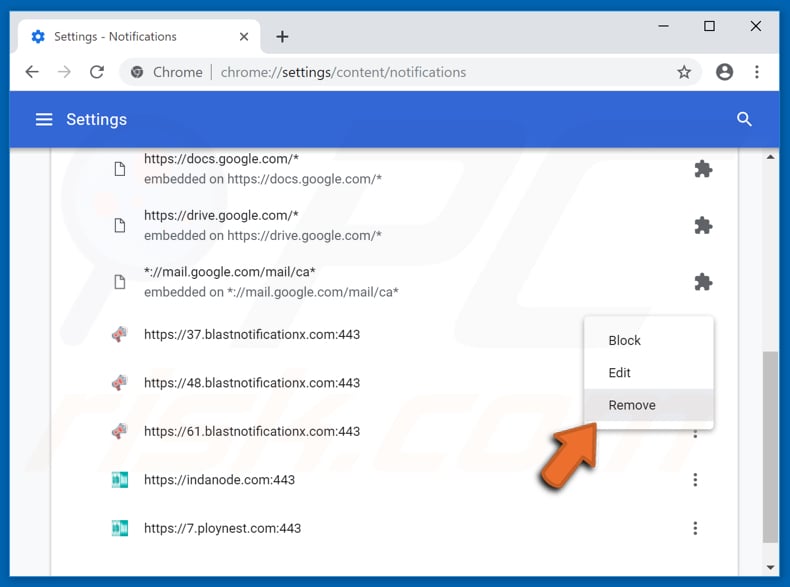
Google Chrome (Android):
- Click on the Menu button (three dots) on the right upper corner of the screen and click "Settings"
- Scroll down, click on "Site settings" and then "Notifications"
- In the opened window, locate all suspicious URLs and click on them one-by-one
- Select "Notifications" in the "Permissions" section and set the toggle button to "OFF"
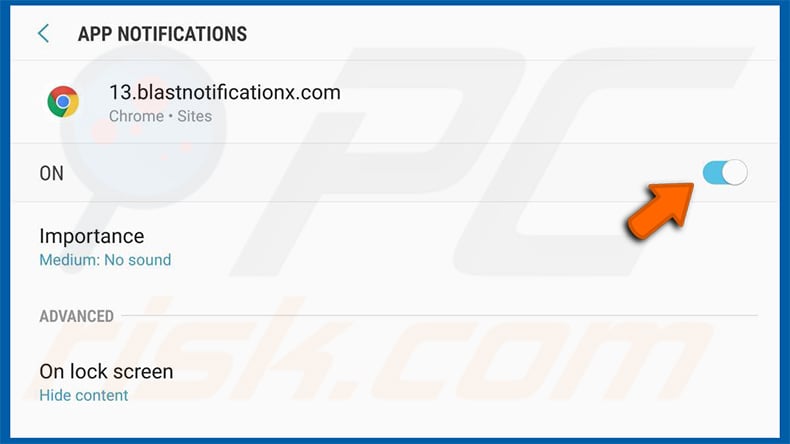
Mozilla Firefox:
- Click the Menu button (three bars) on the right upper corner of the screen
- Select "Options" and click on "Privacy & Security" in the toolbar on the left hand side of the screen
- Scroll down to the "Permissions" section and click the "Settings" button next to "Notifications"
- In the opened window, locate all suspicious URLs, click the drop-down menu and select "Block"
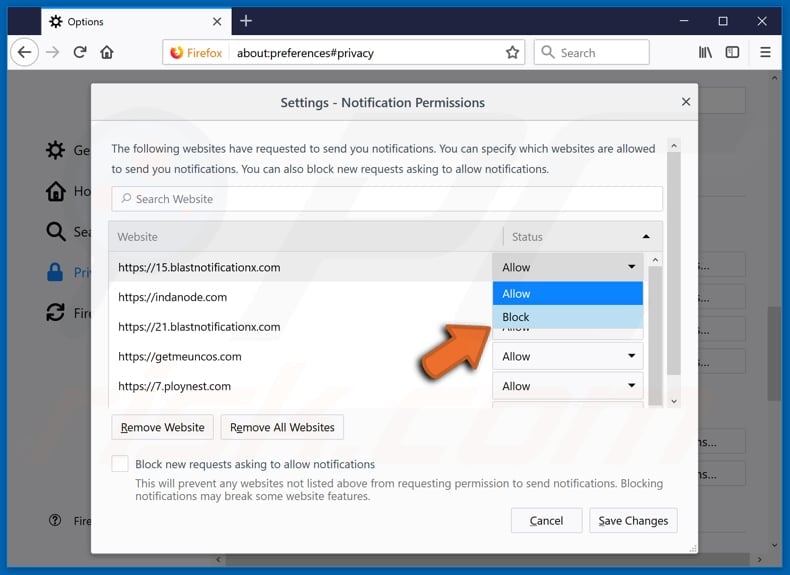
Internet Explorer:
- Click the Gear button on the right upper corner of the IE window
- Select "Internet options"
- Select the "Privacy" tab and click "Settings" under "Pop-up Blocker" section
- Select suspicious URLs under and remove them one by one by clicking the "Remove" button
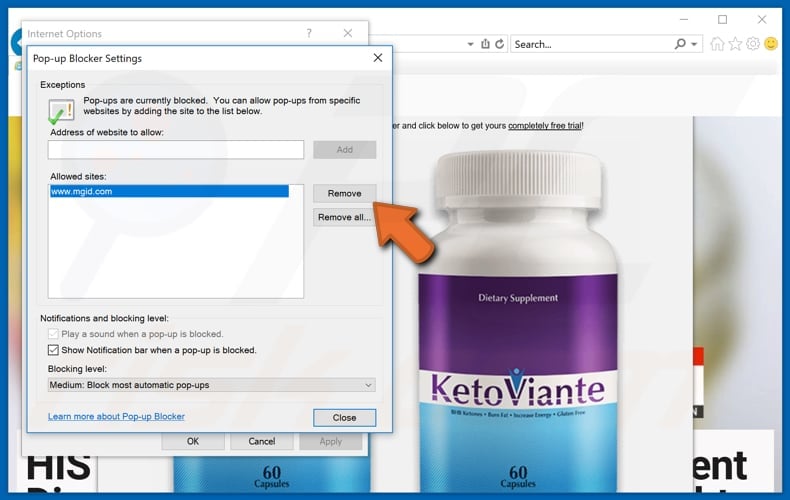
Microsoft Edge:
- Click the menu button (three dots) on the right upper corner of the Edge window
- Scroll down, find and click "Settings"
- Scroll down again and click "View advanced settings"
- Click "Manage" under "Website permissions"
- Click the switch under each suspicious website
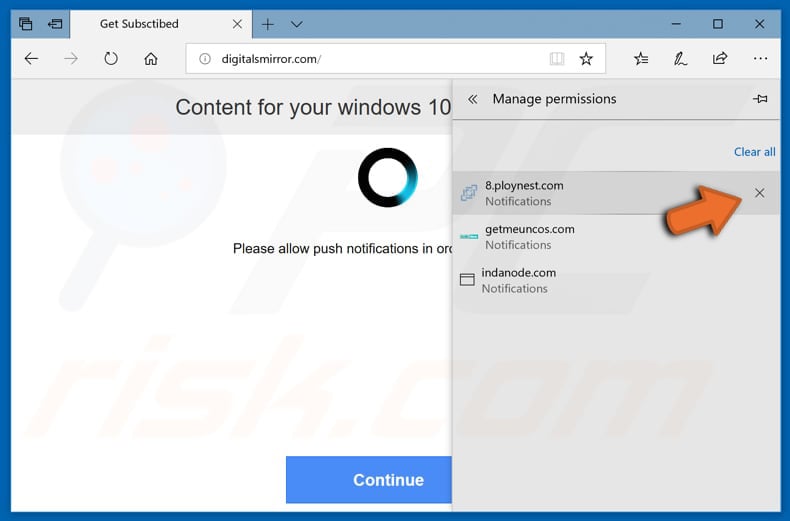
Safari (Mac):
- Click "Safari" button on the left upper corner of the screen and select "Preferences..."
- Select the "Websites" tab and then select "Notifications" section on the left pane
- Check for suspicious URLs and apply the "Deny" option for each
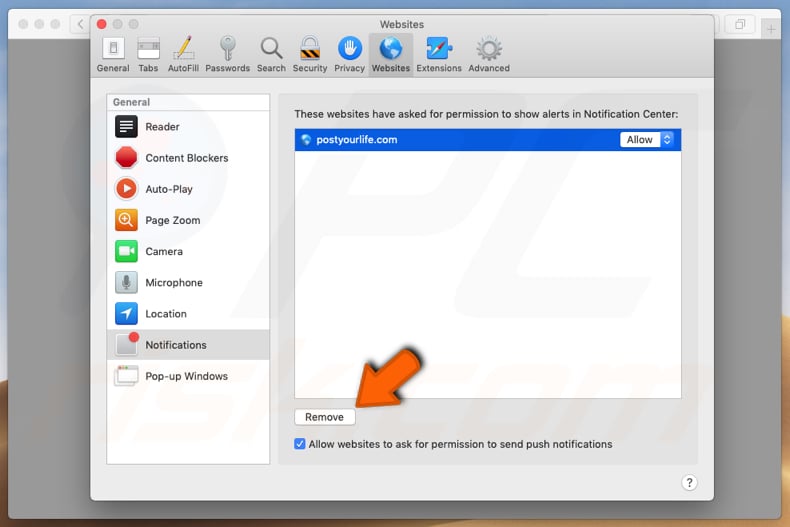
Instant automatic malware removal:
Manual threat removal might be a lengthy and complicated process that requires advanced IT skills. Combo Cleaner is a professional automatic malware removal tool that is recommended to get rid of malware. Download it by clicking the button below:
DOWNLOAD Combo CleanerBy downloading any software listed on this website you agree to our Privacy Policy and Terms of Use. To use full-featured product, you have to purchase a license for Combo Cleaner. 7 days free trial available. Combo Cleaner is owned and operated by RCS LT, the parent company of PCRisk.com.
Quick menu:
- What is 1337x[.]to?
- STEP 1. Uninstall adware applications using Control Panel.
- STEP 2. Remove adware from Internet Explorer.
- STEP 3. Remove rogue plug-ins from Google Chrome.
- STEP 4. Remove adware-type extensions from Mozilla Firefox.
- STEP 5. Remove malicious extensions from Safari.
- STEP 6. Remove rogue plug-ins from Microsoft Edge.
Adware removal:
Windows 11 users:

Right-click on the Start icon, select Apps and Features. In the opened window search for the application you want to uninstall, after locating it, click on the three vertical dots and select Uninstall.
Windows 10 users:

Right-click in the lower left corner of the screen, in the Quick Access Menu select Control Panel. In the opened window choose Programs and Features.
Windows 7 users:

Click Start (Windows Logo at the bottom left corner of your desktop), choose Control Panel. Locate Programs and click Uninstall a program.
macOS (OSX) users:

Click Finder, in the opened screen select Applications. Drag the app from the Applications folder to the Trash (located in your Dock), then right click the Trash icon and select Empty Trash.
![1337x[.]to adware uninstall via Control Panel](/images/stories/screenshots202003/1337x-to-ads-programs.jpg)
In the uninstall programs window, look for any potentially unwanted applications, select these entries and click "Uninstall" or "Remove".
After uninstalling the potentially unwanted application that causes 1337x[.]to redirects, scan your computer for any remaining unwanted components or possible malware infections. To scan your computer, use recommended malware removal software.
DOWNLOAD remover for malware infections
Combo Cleaner checks if your computer is infected with malware. To use full-featured product, you have to purchase a license for Combo Cleaner. 7 days free trial available. Combo Cleaner is owned and operated by RCS LT, the parent company of PCRisk.com.
Remove adware from Internet browsers:
Video showing how to remove potentially unwanted browser add-ons:
 Remove malicious add-ons from Internet Explorer:
Remove malicious add-ons from Internet Explorer:
![Removing 1337x[.]to ads from Internet Explorer step 1](/images/stories/screenshots202003/1337x-to-ads-ie1.jpg)
Click the "gear" icon ![]() (at the top right corner of Internet Explorer), select "Manage Add-ons". Look for any recently-installed suspicious browser extensions, select these entries and click "Remove".
(at the top right corner of Internet Explorer), select "Manage Add-ons". Look for any recently-installed suspicious browser extensions, select these entries and click "Remove".
![Removing 1337x[.]to ads from Internet Explorer step 2](/images/stories/screenshots202003/1337x-to-ads-ie2.jpg)
Optional method:
If you continue to have problems with removal of the 1337x.to pop-up, reset your Internet Explorer settings to default.
Windows XP users: Click Start, click Run, in the opened window type inetcpl.cpl In the opened window click the Advanced tab, then click Reset.

Windows Vista and Windows 7 users: Click the Windows logo, in the start search box type inetcpl.cpl and click enter. In the opened window click the Advanced tab, then click Reset.

Windows 8 users: Open Internet Explorer and click the gear icon. Select Internet Options.

In the opened window, select the Advanced tab.

Click the Reset button.

Confirm that you wish to reset Internet Explorer settings to default by clicking the Reset button.

 Remove malicious extensions from Google Chrome:
Remove malicious extensions from Google Chrome:
![Removing 1337x[.]to ads from Google Chrome step 1](/images/stories/screenshots202003/1337x-to-ads-chrome1.jpg)
Click the Chrome menu icon ![]() (at the top right corner of Google Chrome), select "More tools" and click "Extensions". Locate all recently-installed suspicious browser add-ons and remove them.
(at the top right corner of Google Chrome), select "More tools" and click "Extensions". Locate all recently-installed suspicious browser add-ons and remove them.
![Removing 1337x[.]to ads from Google Chrome step 2](/images/stories/screenshots202003/1337x-to-ads-chrome2.jpg)
Optional method:
If you continue to have problems with removal of the 1337x.to pop-up, reset your Google Chrome browser settings. Click the Chrome menu icon ![]() (at the top right corner of Google Chrome) and select Settings. Scroll down to the bottom of the screen. Click the Advanced… link.
(at the top right corner of Google Chrome) and select Settings. Scroll down to the bottom of the screen. Click the Advanced… link.

After scrolling to the bottom of the screen, click the Reset (Restore settings to their original defaults) button.

In the opened window, confirm that you wish to reset Google Chrome settings to default by clicking the Reset button.

 Remove malicious plug-ins from Mozilla Firefox:
Remove malicious plug-ins from Mozilla Firefox:
![Removing 1337x[.]to ads from Mozilla Firefox step 1](/images/stories/screenshots202003/1337x-to-ads-ffox1.jpg)
Click the Firefox menu ![]() (at the top right corner of the main window), select "Add-ons". Click "Extensions", in the opened window, remove all recently-installed suspicious browser plug-ins.
(at the top right corner of the main window), select "Add-ons". Click "Extensions", in the opened window, remove all recently-installed suspicious browser plug-ins.
![Removing 1337x[.]to ads from Mozilla Firefox step 2](/images/stories/screenshots202003/1337x-to-ads-ffox2.jpg)
Optional method:
Computer users who have problems with 1337x.to pop-up removal can reset their Mozilla Firefox settings.
Open Mozilla Firefox, at the top right corner of the main window, click the Firefox menu, ![]() in the opened menu, click Help.
in the opened menu, click Help.

Select Troubleshooting Information.

In the opened window, click the Refresh Firefox button.

In the opened window, confirm that you wish to reset Mozilla Firefox settings to default by clicking the Refresh Firefox button.

 Remove malicious extensions from Safari:
Remove malicious extensions from Safari:

Make sure your Safari browser is active, click Safari menu, and select Preferences....

In the opened window click Extensions, locate any recently installed suspicious extension, select it and click Uninstall.
Optional method:
Make sure your Safari browser is active and click on Safari menu. From the drop down menu select Clear History and Website Data...

In the opened window select all history and click the Clear History button.

 Remove malicious extensions from Microsoft Edge:
Remove malicious extensions from Microsoft Edge:

Click the Edge menu icon ![]() (at the upper-right corner of Microsoft Edge), select "Extensions". Locate all recently-installed suspicious browser add-ons and click "Remove" below their names.
(at the upper-right corner of Microsoft Edge), select "Extensions". Locate all recently-installed suspicious browser add-ons and click "Remove" below their names.

Optional method:
If you continue to have problems with removal of the 1337x.to pop-up, reset your Microsoft Edge browser settings. Click the Edge menu icon ![]() (at the top right corner of Microsoft Edge) and select Settings.
(at the top right corner of Microsoft Edge) and select Settings.

In the opened settings menu select Reset settings.

Select Restore settings to their default values. In the opened window, confirm that you wish to reset Microsoft Edge settings to default by clicking the Reset button.

- If this did not help, follow these alternative instructions explaining how to reset the Microsoft Edge browser.
Summary:
 Commonly, adware or potentially unwanted applications infiltrate Internet browsers through free software downloads. Note that the safest source for downloading free software is via developers' websites only. To avoid installation of adware, be very attentive when downloading and installing free software. When installing previously-downloaded free programs, choose the custom or advanced installation options – this step will reveal any potentially unwanted applications listed for installation together with your chosen free program.
Commonly, adware or potentially unwanted applications infiltrate Internet browsers through free software downloads. Note that the safest source for downloading free software is via developers' websites only. To avoid installation of adware, be very attentive when downloading and installing free software. When installing previously-downloaded free programs, choose the custom or advanced installation options – this step will reveal any potentially unwanted applications listed for installation together with your chosen free program.
Post a comment:
If you have additional information on 1337x.to pop-up or it's removal please share your knowledge in the comments section below.
Frequently Asked Questions (FAQ)
I have clicked on ads, is my computer infected?
It is unlikely that clicking on an advert will trigger a malware infection, as this is an uncommon technique. An advertisement is more likely to redirect to a malicious website that either tricks visitors into downloading/installing malware themselves or infiltrating it stealthily.
Is 1337x[.]to a virus?
1337x[.]to is not considered to be a virus, but it may endorse virulent content. Sites that utilize rogue advertising networks promote online scams, unreliable/hazardous software, and even malware.
Will Combo Cleaner eliminate the threats posed by 1337x[.]to website?
Combo Cleaner is designed to remove all kinds of threats. It can scan visited websites and detect rogue, deceptive, and malicious pages. It can also restrict all further access to such sites. Additionally, Combo Cleaner is capable of scanning downloaded files for harmful and malicious content.
Share:

Tomas Meskauskas
Expert security researcher, professional malware analyst
I am passionate about computer security and technology. I have an experience of over 10 years working in various companies related to computer technical issue solving and Internet security. I have been working as an author and editor for pcrisk.com since 2010. Follow me on Twitter and LinkedIn to stay informed about the latest online security threats.
PCrisk security portal is brought by a company RCS LT.
Joined forces of security researchers help educate computer users about the latest online security threats. More information about the company RCS LT.
Our malware removal guides are free. However, if you want to support us you can send us a donation.
DonatePCrisk security portal is brought by a company RCS LT.
Joined forces of security researchers help educate computer users about the latest online security threats. More information about the company RCS LT.
Our malware removal guides are free. However, if you want to support us you can send us a donation.
Donate
▼ Show Discussion